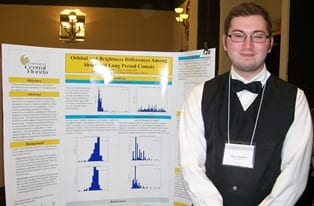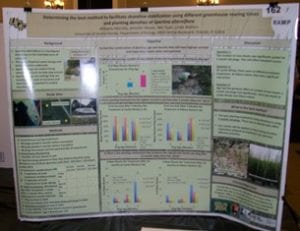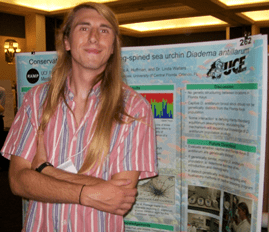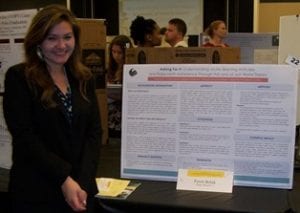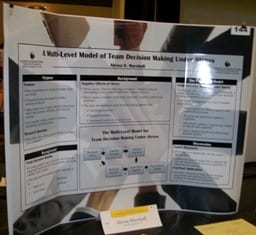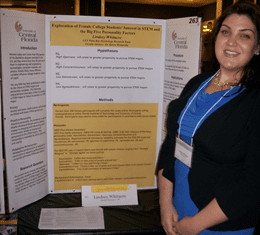Science SURE is Awesome
Thursday, April 3, students, professors and family members crowded the Pegasus Ballroom in the Student Union for the Showcase of Undergraduate Research Excellence (SURE) Conference. The entire ballroom was covered almost wall-to-wall with fascinating and innovative research presentations. Each student had a trifold poster on display. They stood next to their work and answered questions from curious attendees and judges. Many attendee’s faces lit up with smiles when they understood a difficult-to-grasp project or concept. The student researchers seemed more than happy to play professor for the day by teaching others about their projects. For a full listing of the Showcase of Undergraduate Research Excellence participants, click here. Below are some highlights from the college of sciences.
Maury Knudsen, a planetary sciences major, was one such presenter. He patiently explained his research on long and short period comets to anyone who approached his set up. “What is so interesting [to me] about long period comets is that they can help prove what the early solar system looked like,” said Knudsen. His research focused on whether long period and short period comets had more or less in common. Their brightness differed, showing distinct characteristics between the two types. Yet when charting the comet’s orbital patterns, the two types were eerily similar in their paths. Knudsen concludes that more research testing more variables must be done before a firm conclusion can be reached.
While a good number of students focused on solving today’s science enigmas, many also looked to future problems such as conservation. Two students projects which stood out were Mikaela Morolla’s poster on “Determining the Best Method to Facilitate Shoreline Stabilization Using Different Greenhouse Rearing Times and Planting Densities of Spartina alterniflora,” and Sören Webber’s project on “Genetic Structuring of the Long-Spined Sea Urchin Between Captive and Florida Keys Populations.”
Morolla conducted a number of field work experiments with Spartina alterniflora, which is often used in ‘living shoreline’ projects to disperse wave energy to stop sediments and shorelines from eroding. At two sites in Indian River Lagoon, Fla., her group was able to tentatively pinpoint the optimal greenhouse rearing times and planting densities to ensure the plant’s maximum survival and new shoot growth.
Webber is researching ways to boost Florida’s long-spined sea urchin population. A pathogen wiped out over 90 percent of the population in the ’80s. Webber says it’s important to have more long-spined sea urchins in the oceans because they eat algae and live near coral reefs. Without the sea urchins to eat the algae, coral reefs deteriorate, fish begin getting sick and dying, basically it effects the ecosystem all the way down. Webber is looking for ways to breed more resilient long-spined sea urchins, but says the research is tricky. He wants to protect the sea urchins from the pathogen which nearly wiped them out in the ’80s, but not if it means making them more genetically vulnerable to other dangers.
It was pleasantly surprising to see so much social science research on display at the showcase. Ideas about science tend to skew towards physics, astronomy and biology, which are all fabulous topics to pursue a career in. Still, it was nice to see more of the ‘soft side’ of science represented. Many social science projects this year focused on issues relevant to college students, which may drum up more interest for the research. A few of the posters with interesting ideas were Fawn Bolak’s “Asking For It: Understanding Victim-Blaming Attitudes and Rape Myth Adherence Through the Lens of Just World Theory,” Alyssa Marshall’s “A Multilevel Model of Team Decision Making Under Stress,” and Lindsey Whitacre’s “Exploration of Female College Student’s Interest in STEM and the Big Five Personality Factors.”
Bolak is researching, through an online survey with questions she prepared, if there is a correlation between individuals blaming victims of rape and subscribing to just world theory. Just world theory is where individuals have a strong desire or need to believe the world is a just, orderly and predictable place where people get what they deserve. If there does prove to be a correlation with just world theory and victim-blaming, it may be possible to educate individuals and possibly change their attitudes about rape myths.
Marshall’s study combines previous team decision making frameworks and creates a multilevel model for team decision making under stress. Her research outlines the effects of stress on specific processes, emergent states and how it ultimately effects outcomes within team decision making.
Whitacre, Psychology major, is researching a link between the big five personality factors (neuroticism, openness, agreeableness, extroversion and conscientiousness). She proposes females with high openness (revolutionary thinkers, take on world views, open to new experiences), low extroversion (not the first to speak up, gets tired after social interactions) , high conscientiousness (very goal-oriented, focused) and low agreeableness (trying to make everyone around them happy) are the ideal candidates to be drawn to a STEM major. “50 percent of women are awarded bachelors degrees, but only 20 percent of them are in STEM majors. If we can identify personality traits in young females, which match up with them pursuing a career in a STEM major, we can learn to spot these personality traits and become better mentors,” said Whitacre. Instead of mostly encouraging females to pursue more traditionally accepted careers, like nurse, teacher, secretary, etc. We could instead foster an interest in a variety of jobs, including STEM careers.
The College of Sciences would like to thank all of the students and professor mentors for their work in preparing for this showcase.
In addition to the undergraduate research showcase, Research Week put on a Graduate Research Forum where graduate students could present their latest findings. Many students were honored with awards for excellent research in their respective categories. For a full list of winners, please click here.

